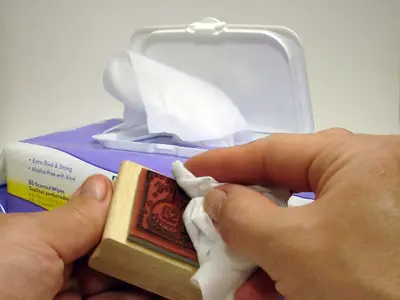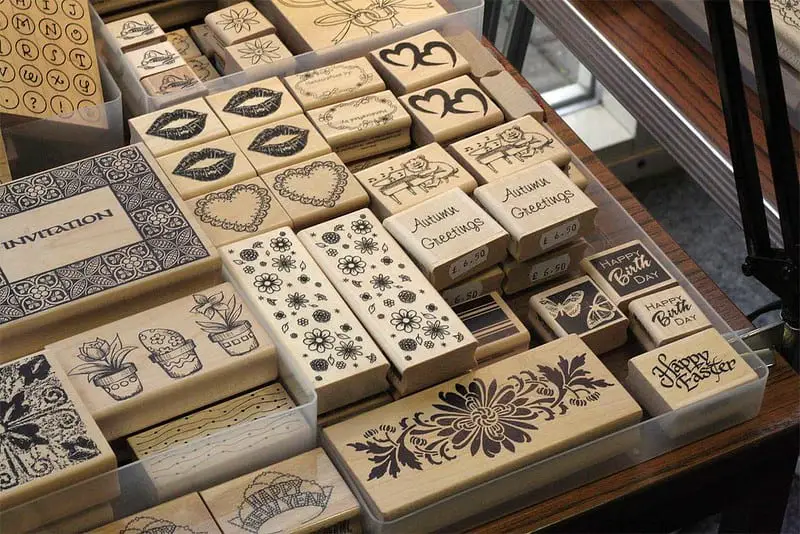From nail art, to card invitations, rubber stamping has been making a comeback in the art world. If you have been wanting to add some fun and vibrant colors to your stamping project, you’re in luck!
So, can you use acrylic paint with rubber stamps? Yes! You can definitely use acrylic paint with your rubber stamps. Other paints with oil ingredients act as solvents on rubber compounds, which results in both the rubber degrading and the oil paint remaining tacky long-term. Because of this, acrylic paints are one of the best paints to use with rubber stamps.
My favorite and recommended acrylic paint set for rubber stamping is this one from Arteza. They have so many colors to chose from such as neons, metallics and even in a matte finish.
Stamping With Acrylics
The best tool to apply acrylic paint to your rubber stamps is a sponge. Any clean makeup sponge or other type of art sponge with an even surface should work. If you’re looking for a fun stamp set, I recommend the brand Lakema. They have a wide variety of stamps at a great price.
If you don’t have any sponges on hand and just can’t wait to get your idea on canvas, you can also use a stipple brush or lightly spread the paint on a palette with a flat brush until dipping the stamp into the paint smear will only cover the surface of the stamp.
Unlike stamping with inks, pressing firmly on the stamp to transfer acrylic paint can cause smearing. To figure out the perfect pressure and point for stamp coverage, practice stamping a few times on a scrap of material similar to what you’re using for your final application.
You can use a different material if you don’t have any excess for practice, but keeping the conditions the same across the board ensures the most reliable application. This is a great reason to buy a bit more material than necessary for a project.
Testing out techniques in a low stakes way in the same environment is satisfying and helpful for making visual adjustments before the final application.
Measure Twice, Sponge Once

Just like working with any ink medium in stamping, the best results in acrylic stamping come when the paint is carefully applied only to the rubber components you want to transfer. Even if the relief portion of the stamp seems fairly deeply ingrained, excess paint can pool and shift during transfer.
Rubber stamping acrylics is a lot like building furniture or sewing with the measure twice, cut once principle. Successful stamping is all about preparation and in maintaining your tools.
Cleaning Acrylic Paint from Rubber Stamps

To clean your rubber stamps, use a rubber stamp cleaner like this one, or a paper towel/cloth to clean your stamps without submerging the wood or acrylic mount portions. Submerging the part where the rubber meets the wood or plastic can cause the glue holding them together to break down.
Cleaning acrylic paint from rubber stamps is very similar to removing ink. First, repeatedly apply the stamp to a piece of scrap paper until no more paint comes off the stamp.
Next spray a rubber stamp cleaner onto the rubber surface and blot or wipe the paint away until no more paint releases. The process takes less than a minute if the stamps are cleaned right after use.
If the acrylic paint has set in or dried first, using a stamp scrubber or a tooth brush with a stamp cleaner can gently dislodge the pigment. Stubborn paint can also be removed by wiping them with soap and water or alcohol-free baby wipes. No matter how you clean your stamps, always let them dry completely before storing.
Acrylic paint may stain your stamps, depending on the pigment, even if you wash them relatively quickly after use. Stained stamps work just as well as pristine ones though. The primary goal of cleaning the stamps is to remove any buildup that may affect the smooth transfer of pigment.
Emboss Resist Stamping

Now that you know how to use and clean rubber stamps with acrylic paint, you can step up your game with the emboss resist technique!
In addition to stamps and acrylic paint, this requires embossing powder and a heat gun. Once you have your supplies and design in mind, apply the embossing powder on areas you don’t want to the paint to absorb. This is why it is called resist, because the embossed area resists further paint transfer.
After you’ve applied the powder precisely where you want it, hold a heat gun over the surface in small circles until the powder begins to melt.
When the embossing powder has transformed and cooled, you can break out the acrylics! Now any paint touching the embossed surfaces can be wiped away with a lightly dampened paper towel. The best part is that you can use the stamps as the embossed areas, or you can emboss the relief portions!
Final Thoughts
From crafting wedding invitations to experimenting with your art style, acrylic painting with rubber stamps offers fun, uniform patterns and versatility in adding textures to art projects.
For all your acrylic painting needs, don’t forget to check out my Recommended Products Page. Happy Painting!

